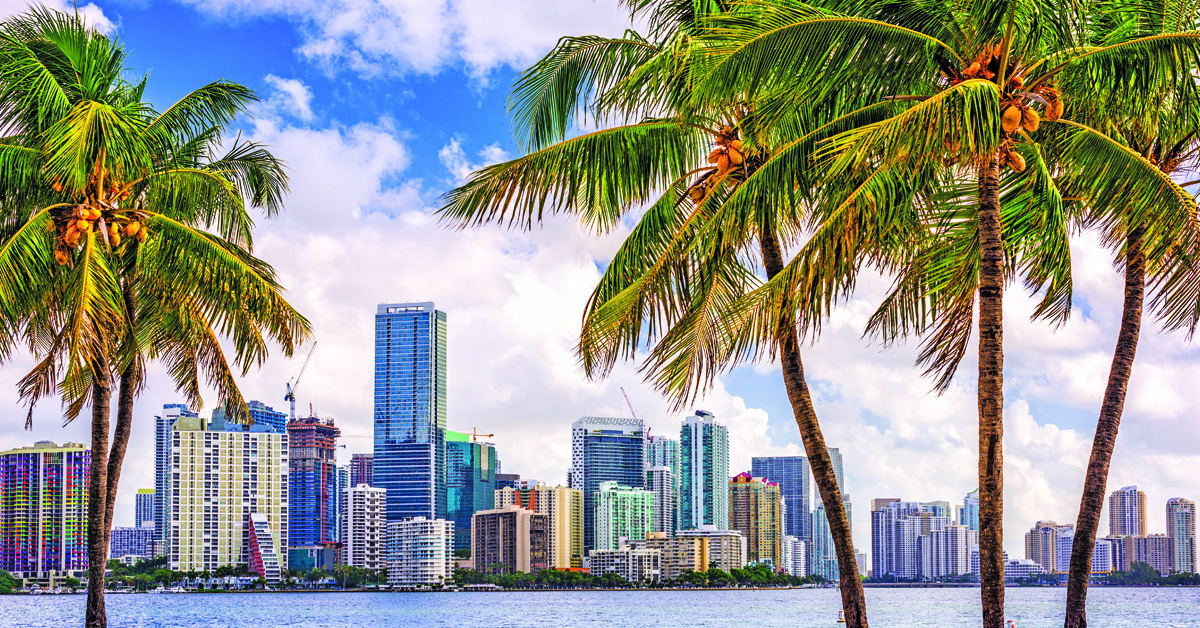Florida is a powerhouse state with a lot to offer: pristine beaches, a powerful economy, Walt Disney World and so much more. But if any one thing can define this state, it’s water. Bordered by the Gulf of Mexico to the west and the Atlantic Ocean to the east — and with more than 7,700 lakes and 300 springs in its interior — Florida is a state built on and around the most plentiful resource on Earth.
Despite its immense presence throughout the state, Florida has a water problem. The Floridan aquifer, an 82,000-square-mile underground reservoir that holds most of the state’s freshwater, is being
threatened by overuse, rising sea levels and saltwater intrusion, according to National Geographic. Some of Florida’s springs are slowing their output, and wetlands have been drained to create land for housing and other development.
A few years ago, the Florida Department of Environmental Protection proposed nearly 750 conservation projects around the state to restore wetlands and create new reservoirs while making new development more sustainable. Floridians are encouraged to water their lawns less and conserve water at home. As the state’s population and economy continue to grow, a water crisis could be avoided through sweeping conservation efforts.
The state’s economy grew in 2021 with a real gross domestic product (GDP) increase of 6.9%, outpacing the nation’s GDP growth of 5.7%. Florida’s $1.2 trillion economy is the nation’s fourth largest, and the state ranks third with a population of 21.8 million residents. Florida also has seen an increase in net migration, adding more than 252,000 new residents from 2019 to 2020 — the highest number for any state. It was the
fifth consecutive year that Florida led the nation in net migration.Florida’s post-pandemic economic growth is welcome after the state recorded a 2.8% GDP decrease in 2020. Tourism, one of the most important sectors of Florida’s economy, took a massive hit that year but rebounded in 2021 as pandemic-related restrictions lifted, allowing the return of millions of visitors.
In first-quarter 2022, Florida had 36 million visitors, according to the office of Gov. Ron DeSantis. It was the third quarter in a row that tourism numbers had surpassed pre-pandemic levels, and hotel demand in Q1 2022 exceeded pre-pandemic levels for the first time.
Florida also has seen growth in its finance, insurance and real estate industries as major companies (many based in New York City) have opened offices in Miami-Dade and West Palm Beach counties. The “Wall Street of the South” has welcomed major players such as Goldman Sachs, Virtu Financial, Point72 Asset Management and Elliott Management.
Along with these firms came a migration of Manhattanites. According to Bloomberg,
West Palm Beach is getting a Manhattan-style makeover that includes outposts of famous New York restaurants, new luxury condominiums, and even plans for a new university campus and neighborhood inspired by the West Village. ●
Single-family home sales in Florida have started to cool as rising interest rates and home prices have slowed demand. Sales in May 2022 were down 6.9% year over year, according to Florida Realtors. That was an improvement from the month before, however, as sales declined by 15.3% annually in April.
Due to decreased demand, for-sale inventory rose significantly in May, with more than 40,000 homes on the market. This represented a 31.5% increase from May 2021, but available inventory in Florida is still considerably lower than pre-pandemic levels, which averaged 80,000 to 100,000 homes listed in any given month.
Despite cooling sales, home prices have continued to rise in Florida. In May 2022, the median sales price for a single-family home rose to $420,000, a 21.8% increase over the prior year. And these increased home values translated to a 7.7% boost in the total dollar volume of home sales compared to May 2021.
Focus: Technology
In December 2020,
Miami Mayor Francis Suarez sent out a four-word tweet to a venture capitalist who proposed moving Silicon Valley to Miami: “How can I help?” Millions of views, several news headlines and even apparel branded with the “How can I help?” slogan followed the tweet, sparking a new campaign to bring more tech to Miami.
Florida has campaigned for years to grow its tech industry — after all, the first personal computer was produced by IBM in Boca Raton — but business has boomed most significantly in the past year. In 2021, Florida saw the second highest growth of any state for tech employment, adding 10,500 new jobs, according to the Computing Technology Industry Association.
Florida ranked No. 1 for the addition of new tech businesses, with 2,715 enterprises registering in the state in 2021. Miami is a hot spot for startups, with billions in venture capital being invested each year. Aventura Magazine estimated that from early 2020 to early 2022, about $1 trillion in new tech assets were added to the South Florida economy.
What the locals say
“I wholeheartedly believe Southeast Florida currently is, and will continue to be, the most desirable area to live in the U.S. Many employees now opting to work from home or moving out of colder climates are enjoying the warm weather and pristine beaches. South Florida is also rich with Latin and European culture; it’s no longer just a mecca for retirees. The housing market here has been strong over the last 12 months. We are starting to face headwinds with rising interest rates and some pockets of softening demand … [but we are continuing to] beat out other offers and help our buyers and agent partners succeed.”
Craig Stelzer
Originating branch manager
CrossCountry Mortgage LLC
3 Cities to Watch
St. Petersburg

St. Petersburg, nicknamed the “Sunshine City,” is known for pleasant weather and enjoys an average of 361 days of sunshine per year. With a population of 258,000, St. Pete is the fifth largest city in Florida, and it is part of the greater Tampa-St. Petersburg-Clearwater metro area, which is home to some 3.2 million people. According to Florida Realtors, metro-area home prices jumped 28.4% from May 2021 to May 2022, and the median price now stands at $413,000. The city’s median income is $60,798.
Jacksonville

Located on the Atlantic coast near the Georgia border, Jacksonville is Florida’s largest city with 954,000 residents. Jacksonville is known for its expansive parks, which total 80,000 acres, as well as 22 miles of beaches. Its location makes it attractive to the U.S. military, which employs about 50,000 people in the area. Metro-area home prices were up 27% year over year this past May to reach a median sales price of $400,000, Florida Realtors reported. The city’s median income is $55,531.
Tallahassee

Located on the Panhandle, Florida’s capital city is relatively small, with a metro-area population of about 385,000. Although it’s well known for politics, Tallahassee may be best recognized as a college town, with a student population of roughly 70,000. The city is home to Florida State University, Florida A&M University and Tallahassee Community College. Tallahassee-area home prices were up 16.2% year over year for a median sales figure of $310,000 this past May. The city’s median income is $46,461.
Sources: Aventura Magazine, Bloomberg, Business Development Board of Palm Beach County, City of St. Petersburg, Florida Realtors, National Geographic, Office of Gov. Ron DeSantis, Palm Beach Post, Redfin, Tampa Bay Economic Development Council, Tampa Bay Times, University of South Florida, U.S. Bureau of Economic Analysis, Visit Jacksonville, Visit Tallahassee, WFLA News
-
Hannah Darden is the former industry rankings editor at Scotsman Guide Inc.
View all posts














